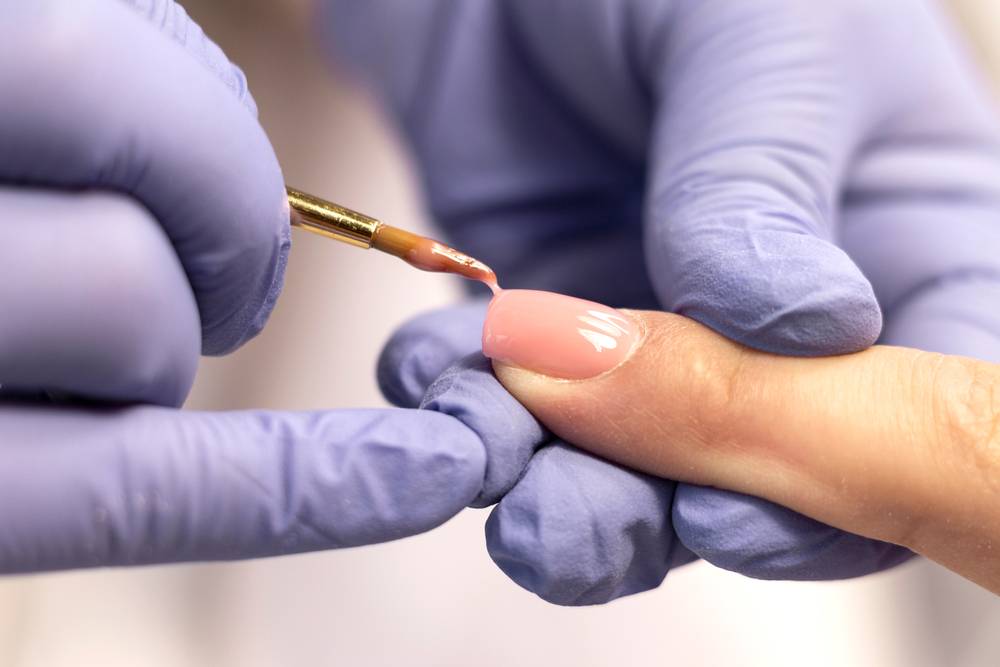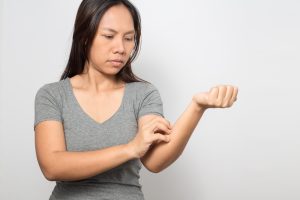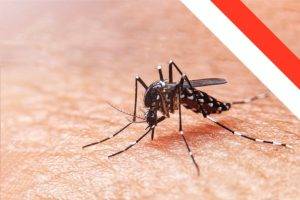A sudden onset of allergic reactions from gel nails, a popular choice for modern manicures, has left many in a scratch.
Chemicals such as methyl acrylate play a pivotal role in causing allergies associated with gel nails.
This acrylic compound is known to induce skin irritation, frequently manifesting as contact dermatitis—a skin condition characterised by redness, itching, and blistering. Acrylates, including methyl acrylate, have well-documented roles as contributors to allergic contact dermatitis, especially within the beauty industry, marking a transition from their earlier association with the dental profession.
Typically, the diagnosis of this allergy relies on patch testing. A positive result necessitates avoiding all methacrylates due to their considerable potential for cross-reactivity. Recent trends have shown a rise in the incidence of allergic contact dermatitis stemming from (meth)acrylates found in nail products, affecting both nail technicians and consumers. This highlights a growing concern, emphasising the need for heightened awareness and precaution among gel nail enthusiasts.
Moreover, studies have revealed varying rates of reactions to different types of acrylates. For example, research by the North American Contact Dermatitis Group during 2015-2016 demonstrated reaction rates ranging from 3.4% for 2-hydroxyethyl methacrylate to 1.4% for methyl methacrylate. This highlights the significant likelihood of these reactions being at least somewhat relevant.
Additionally, the presence of methyl acrylate in conventional nail polish has been identified. The resulting contact dermatitis can negatively impact an individual’s ability to work, occasionally leading to sick leave. This highlights the broader implications of acrylate-induced nail contact allergies.
The Scientific Standpoint
Recent investigations highlight a significant prevalence of allergic reactions among users of gel nail products. A study involving 2,118 participants revealed that 48.3% experienced adverse effects during the application of gel nail polish, approximately 20% while wearing it, and more than 75% reported issues after its removal. This data highlights the enduring impact of the allergens involved, especially given the notable increase in nail plate changes post-removal.
These allergies are primarily provoked by chemicals such as acrylates, which are notorious for causing skin irritations. These irritations typically manifest as contact dermatitis, characterised by redness, itching, and blistering. There has been a transition of acrylate allergies from the dental sector to the beauty industry, particularly concerning gel nails, over the years. Acrylate compounds, including methyl acrylate, play a crucial role in these allergic reactions, necessitating increased awareness among gel nail enthusiasts.
Confirming allergic contact dermatitis typically involves conducting patch testing. When identifying a contact allergy, it becomes crucial to avoid all methacrylates due to their substantial potential for cross-reactivity. The increasing occurrences of allergic contact dermatitis caused by acrylates in nail products, impacting both nail technicians and consumers, highlight a growing concern.
Furthermore, the cosmetic allure of nail aesthetics, including nail sculpting, gel nails, and long-lasting polishes, has witnessed a surge in popularity. Alongside this trend, there has been an increase in cases of allergic contact dermatitis among both aestheticians and customers.
These studies and data collectively highlight the necessity for individuals who frequent nail beauty services or are deeply involved in this industry to increase awareness and engage with caution.
Professional vs Home Application
The professional application of gel nails might offer a safer haven, as the study indicates a correlation between the occurrence of side effects and the professionalism of the application. Education regarding the risks and the proper technique of application can significantly curtail the likelihood of allergic reactions, showcasing a preventive pathway towards safer gel nail practices.
Precautionary Measures
When it comes to enjoying the beauty of gel nails while minimising the risk of allergies, precautionary measures are your best defence:
Choose Hypoallergenic Products
- Opt for gel nail products that are labelled as hypoallergenic or low in allergenic compounds. These products are formulated to minimise the risk of triggering allergic reactions.
- Read product labels and ingredient lists carefully to identify any potential allergens.
Professional Services
- When getting gel nails, it’s advisable to visit a professional nail technician who is experienced in the application and removal of gel nails.
- Professional technicians are more likely to use quality products and follow proper procedures, reducing the risk of exposure to allergens.
Proper Application and Maintenance
- Ensure that the gel nails are applied and maintained correctly. This includes proper cleaning, filing, and resealing of the nails.
- Avoid overexposure to the gel nail products, as prolonged contact can increase the risk of sensitisation.
Immediate Discontinuation
- If you notice any allergic symptoms, discontinue the use of gel nails immediately. Continued exposure can worsen the allergic reaction.
- Remove the gel nails gently and avoid causing further irritation.
Consultation with a Dermatologist
- After discontinuing gel nail use due to allergic symptoms, it’s highly advisable to consult with a dermatologist.
- Dermatologists can assess the severity of the allergic reaction, provide appropriate treatment, and offer guidance on managing and preventing future reactions.
Alternative Nail Treatments
- If you are prone to allergies or have experienced gel nail allergies in the past, consider exploring alternative nail treatments such as regular nail polish or acrylic nails.
- Discuss your options with a professional nail technician or dermatologist to find a suitable and less allergenic choice.
A Well-Informed Choice
The allure of gel nails has a caveat. As the beauty industry advances, it also increases the importance of well-informed use of the products. With a proper understanding of the risks involved and by adhering to precautionary measures, you can safely embrace the beauty of gel nails without allergen concerns.
References
- Putek, J., Przybyła, T., Szepietowski, J. C., Baran, W., & Batycka-Baran, A. (2020, January 1). Side-effects Associated with Gel Nail Polish: A Self-questionnaire Study of 2,118 Respondents. Acta Dermato-venereologica; Soc for Publication of Acta Dermato-Venereologica. https://doi.org/10.2340/00015555-3684
- DeKoven, S., & Holness, D. L. (2017, September 17). Contact dermatitis caused by methacrylates in nail products. Canadian Medical Association Journal, 189(37), E1193–E1193. https://doi.org/10.1503/cmaj.170264
- Gregoriou, S., Tagka, A., Velissariou, E., Tsimpidakis, A., Hatzidimitriou, E., Platsidaki, E., Kedikoglou, S., Chatziioannou, A., Κατσαρού, Nicolaidou, E., & Rigopoulos, D. (2020, February 24). The Rising Incidence of Allergic Contact Dermatitis to Acrylates. Dermatitis; Lippincott Williams & Wilkins. https://doi.org/10.1097/der.0000000000000528
- Calado, R., Gomes, T. F., Matos, A. L., & Gonçalo, M. (2021, October 19). Contact Dermatitis to Nail Cosmetics. Current Dermatology Reports; Springer Science+Business Media. https://doi.org/10.1007/s13671-021-00345-2
- Kucharczyk, M., Słowik-Rylska, M., Cyran-Stemplewska, S., Gieroń, M., Nowak-Starz, G., & Kręcisz, B. (2021). Acrylates as a significant causes of allergic contact dermatitis – new sources of exposure. Advances in Dermatology and Allergology, 38(4), 555–560. https://doi.org/10.5114/ada.2020.95848
- Gregoriou, S., Tagka, A., Velissariou, E., Tsimpidakis, A., Hatzidimitriou, E., Platsidaki, E., Kedikoglou, S., Chatziioannou, A., Κατσαρού, Nicolaidou, E., & Rigopoulos, D. (2020, February 24). The Rising Incidence of Allergic Contact Dermatitis to Acrylates. Dermatitis; Lippincott Williams & Wilkins. https://doi.org/10.1097/der.0000000000000528
- Gardeen, S., & Hylwa, S. (2020, September 1). A review of acrylates: Super glue, nail adhesives, and diabetic pump adhesives increasing sensitization risk in women and children. International Journal of Women’s Dermatology; Elsevier BV. https://doi.org/10.1016/j.ijwd.2020.04.007
- Gatica‐Ortega, M., & Pastor‐Nieto, M. (2020, August 18). The Present and Future Burden of Contact Dermatitis from Acrylates in Manicure. Current Treatment Options in Allergy; Springer Science+Business Media. https://doi.org/10.1007/s40521-020-00272-w














